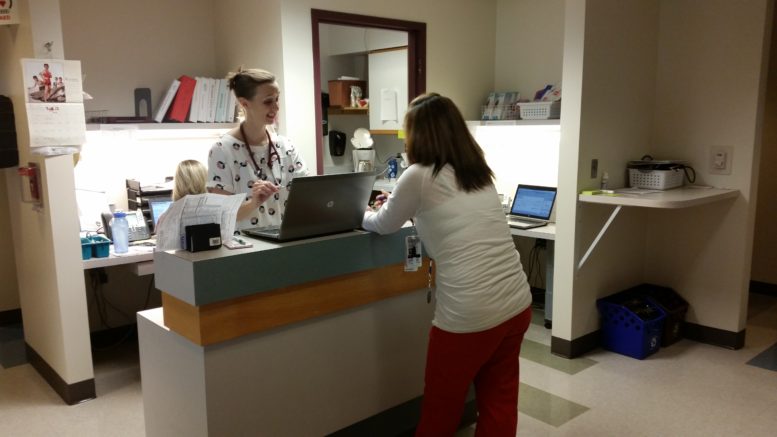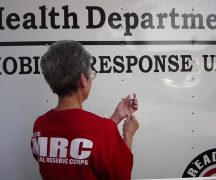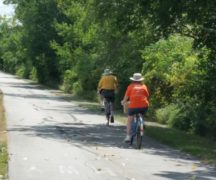By JAN LARSON McLAUGHLIN
BG Independent News
Much of the work of the Wood County Health Department goes unseen and under the radar – since it intervenes to stop illnesses before they can occur.
The agency inspects restaurants, provides immunizations, ensures that sewage doesn’t contaminate waterways, and offers health care to those who can’t afford it elsewhere.
For more than a century, the Wood County Health Department has been the quiet caretaker of the county’s health.
The health department is asking the public to help the agency continue that job, by passing a 0.5-mill renewal levy on the Nov. 3 ballot. The levy will bring in no extra money, and will continue to cost the owner of a $100,000 home $13.16 a year.
The health department asks local residents to help fill the gap between state funding and the costs to protect public health, said Wood County Health Commissioner Ben Robison. According to 2019 statistics, Ohio ranks 47th out of 50 for per capita funding from the state.
“The only reason we are not ranked lower is because we are tied with Arizona and Indiana” also at the bottom of the funding scale, Robison said.
Near the top end, New Mexico funds its local health departments at $220 per capita. In the middle, Louisiana pays $89 per capita. At the bottom, Ohio sends $53 per capita.
That means in Ohio, many local health departments have to turn to voters to help support services, Robison said.
In Wood County, the levy revenue makes up 27% of the health department’s budget. The funding is used strategically to backfill for funds lacking in several program areas, he said.
“Those investments have substantial benefits for the community at large,” Robison said.
Studies show that the return on investments for public health spending is 14 to 1, he said.
“We know these dollars are really being used to have a substantial value down the road,” he said. “There aren’t many investments that pay 14 times on your dollar.”
That’s where much of the health department’s results take place – down the road. By providing care to pregnant women and children, the agency ensures better long-term health. By testing for faulty septic systems, the staff makes sure waterways are protected for wildlife and humans. By inspecting restaurants, the staff makes sure people don’t get sick and businesses don’t have to shut down.
“These programs are critical to things we really value,” Robison said. “Public health is also related to the economic efforts, behavioral health and education efforts.”
The COVID pandemic has drawn the health department into more of the spotlight.
The health department has been giving local businesses, schools and other organizations the guidance they need to open safely in the presence of COVID-19 in the community. The staff has conducted contact tracing for those testing positive for COVID, and has provided ongoing information to the public about what’s happening in their communities, how they can protect their families, and reduce the spread of COVID-19.
“We often come into the limelight during times like COVID,” Robison said.
Meanwhile, ongoing less flashy public health efforts continue such as working to prevent chronic diseases.
“We want people to not only live long, but live well,” Robison said. “Even as we are focused on addressing COVID, we are looking down the road on the other side of COVID.”
To determine where efforts should be targeted, the health department conducts regular community health assessments.
“That helps us identify the health needs of the county,” he said. “Every community has their own sets of needs and priorities.”
One of those needs identified a few years ago resulted in the health department adding a dental clinic to its community health center. Prior to that, local residents without dental insurance had very few options for care.
Wood County’s health levy began in 1991 and since then the 10-year, 0.5 mill levy has continued to provide a stable base of funding that allowed the health department to significantly expand its programs and services.
In 2019 the levy generated just shy of $1.6 million to support local public health. Many of the health department’s programs and services do not receive state funding and require local levy dollars to maintain.
Services that the levy supports (2012-2019):
- Public health nursing. This funding supports infectious disease investigation and follow-up, and vaccine promotion and administration. Since 2013, the levy funding has covered a $1.6 million shortfall in this program.
- Community Health Center programs and services. In the period of 2014 through 2017, before the Wood County Health and Wellness Center became financially self-sustaining, levy funds were used for Health Center programs that served more than 5,000 individuals, provided more than 1,300 preventative services, and dispensed more than 9,500 prescriptions. Since 2012, the levy revenue has put $800,000 toward these services.
- Environmental health programs, such as sewage, water, housing, school and pool inspections. The levy has contributed $195,100 for environmental programs, $423,200 for sewage programs, $177,000 for water programs, and $96,500 for public pool inspections.
- Women, Infants and Children (WIC) services. Local levy dollars supplements state and federal funding, helping pregnant women see doctors earlier and receive timely care. Babies whose mothers use WIC are 33% less likely to die before age 1, and children who participate in WIC are less likely to be obese. The levy funds have made up shortfalls of $433,541 for WIC, and $93,000 for maternal child health.
- Emergency preparedness. The levy revenue has shifted $410,500 for these programs.
To reduce the need for local funding, the health department has secured many grants, including $1 million for the community health center.
“We will continue to be good stewards of those dollars,” Robison said of local funding.
“We want a community that is healthy and thriving,” he said. “That’s what helps us to have a thriving community that people want to live in.”





